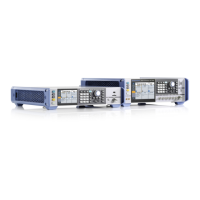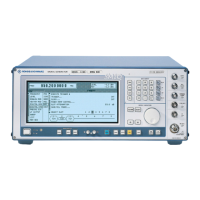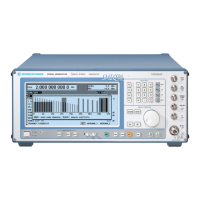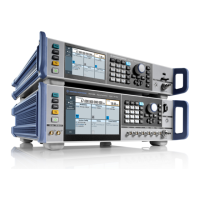SME Test Procedure
1038.6002.02 5.43 E-13
5.2.40.2 Dibit Synchronization
For modulations QPSK and 4FSK a symbol is coded with two successive bits (dibit), i.e. the X bit and
the Y bit. The X bit is at the beginning of the sequence at the START ADDRESS as per definition. To
ensure this allocation the DM coder and XMEM have to be synchronized when the modulation is
switched on.
Measurement
À Read in bit pattern No. 3 in the XMEM via IEC/IEEE bus as
described in the previous section.
À Settings at the SME
- Level 0 dBm
- RF-frequency 900 MHz
in menu DIGITAL MOD QPSK
- SOURCE DATA
- CLOCK MODE BIT
- SELECT LIST XMEM
- CONFIG XMEM START ADDRESS 59
- CONFIG XMEM LENGTH 4.
À Vary the bit rate in the menu DIGITAL MOD QPSK from 30 kbps to
48 kbps in 1-kbps steps.
At 900 MHz ±BITRATE/4 there should be a spectral line exceeding
the level at 900 MHz by 4 dB ±2 dB.
5.2.40.3 External Triggering
Test setup Feed in a positive pulse at the input TRIGGER (rear connector) (pulse
duration >100 ns). Tap signal at the DATA output.
Measurement À Settings at the SME
- Level 0 dBm
- RF-frequency 900 MHz
in menu DIGITAL MOD GMSK
- SOURCE DATA
- CLOCK MODE BIT
- SELECT LIST XMEM
- CONFIG XMEM START ADDRESS 59
- CONFIG XMEM LENGTH 4
- CONFIG XMEM EXT TRIGGER ON.
After triggering, the DATA output should change from HIGH to
LOW for approx. 3.7us.
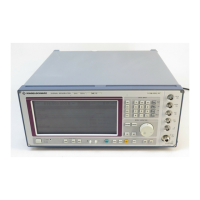
